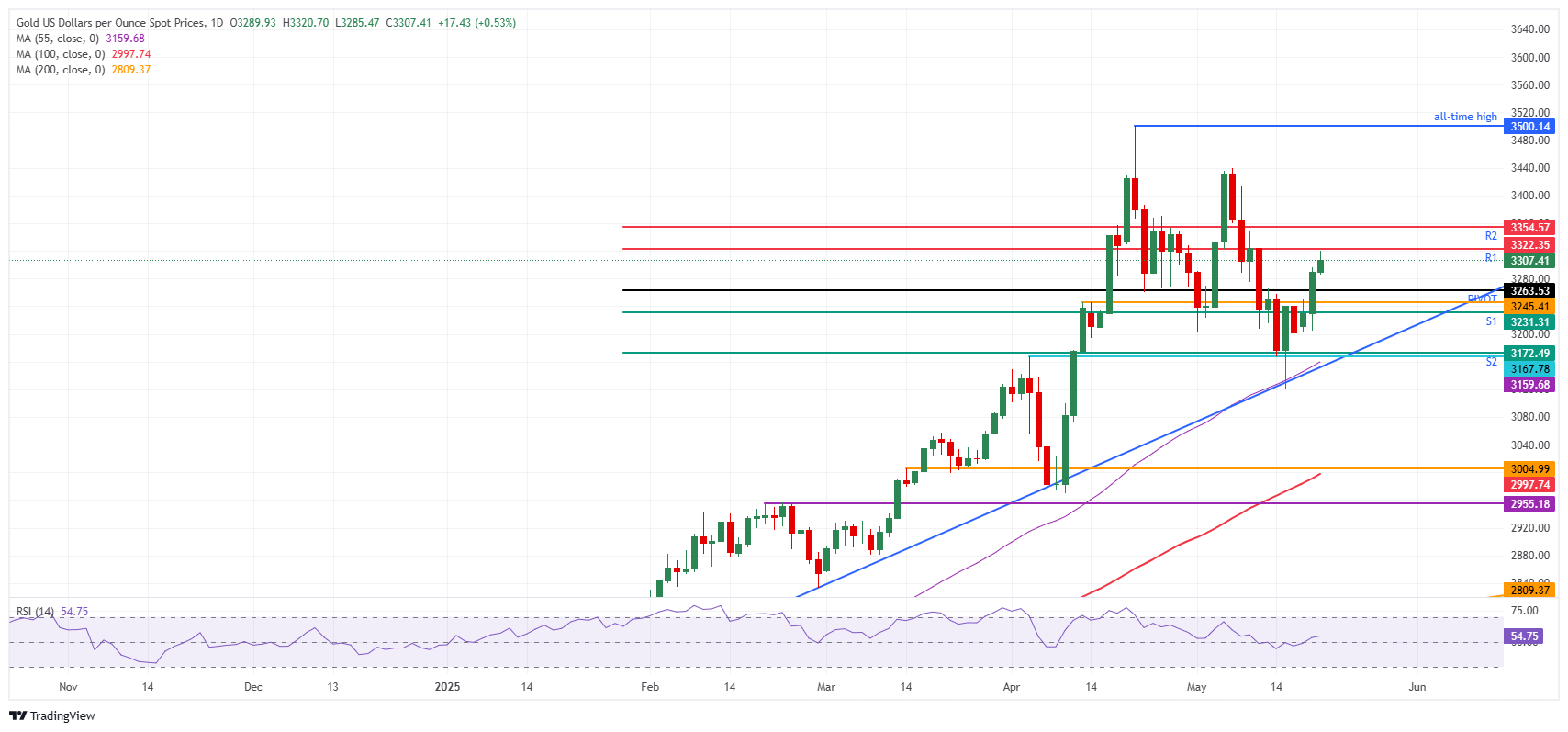- Gold price sees safe haven inflow on comments Israel considers striking Iran nuclear facilities.
- President Trump clashes with Republican members on his fiscal package plan through US Congress.
- Gold has broken out of its tight range and could see follow-through higher.
Gold (XAU/USD) edges higher on Wednesday towards $3,309 at the time of writing, with concerns that tensions in the Middle East might spiral out of control again and Trump’s fiscal bill not passing Congress. In late trading on Tuesday, CNN reported that Israel is considering targeting nuclear sites in Iran. While former United States (US) President Joe Biden was able to change Israel’s Prime Minister Benjamin Netanyahu’s mind, US President Donald Trump has seen his diplomatic efforts fall apart, with markets mulling whether Trump is still able to control Netanyahu.
In the US, President Trump is facing setbacks at home as well as the administration struggles to get enough support to pass through Congress its tax bil. Frustration arose for Trump at Capitol Hill when speaking with lawmakers who demanded to significantly boost the cap on the state and local tax (SALT) deduction.
Daily digest market movers: Quiet on all fronts
- Safe-haven support for Gold was boosted by a CNN report that indicated Israel may be planning a strike on Iranian nuclear facilities. It remains unclear whether a final decision to carry out the attack was made, the report said. Markets will want to look for confirmation from either US or Israel’s leaders.
- On the back of the phone call between US President Trump and Russian President Vladimir Putin, the Vatican has proposed to host any event related to Ukraine-Russia peace talks.
- The Financial Times reports that US lawmakers are pressing Northern Ireland to approve an American-owned Gold mine potentially worth billions of pounds to the local economy, warning that delays to the project risk driving away foreign capital.
Gold Price Technical Analysis: Surprise squeeze
Recent headlines about the Middle East and the deadlock in the US Congress are another hit for President Trump and his credibility, and to a broader extent, the credibility of the US Dollar and the US economy. Gold benefits from uncertainty, and it could peak back above $3,350 should Israel confirm its plans.
On the upside, the R1 resistance at $3,324 is the first level to look out for as it aligns with the high of May 12. The R2 resistance at $3,354 follows not far behind the R1 and could open the door for a return to $3,431, which were the peaks of April 21 and May 6 and 7.
Some thick-layered support emerges on the downside in case Gold price declines. On the downside, the daily pivot comes in at $3,263. Next, there is a technical pivotal level at $3,245, and, just below, $3,231 as the intraday S1.

XAU/USD: Daily Chart
US Dollar FAQs
The US Dollar (USD) is the official currency of the United States of America, and the ‘de facto’ currency of a significant number of other countries where it is found in circulation alongside local notes. It is the most heavily traded currency in the world, accounting for over 88% of all global foreign exchange turnover, or an average of $6.6 trillion in transactions per day, according to data from 2022.
Following the second world war, the USD took over from the British Pound as the world’s reserve currency. For most of its history, the US Dollar was backed by Gold, until the Bretton Woods Agreement in 1971 when the Gold Standard went away.
The most important single factor impacting on the value of the US Dollar is monetary policy, which is shaped by the Federal Reserve (Fed). The Fed has two mandates: to achieve price stability (control inflation) and foster full employment. Its primary tool to achieve these two goals is by adjusting interest rates.
When prices are rising too quickly and inflation is above the Fed’s 2% target, the Fed will raise rates, which helps the USD value. When inflation falls below 2% or the Unemployment Rate is too high, the Fed may lower interest rates, which weighs on the Greenback.
In extreme situations, the Federal Reserve can also print more Dollars and enact quantitative easing (QE). QE is the process by which the Fed substantially increases the flow of credit in a stuck financial system.
It is a non-standard policy measure used when credit has dried up because banks will not lend to each other (out of the fear of counterparty default). It is a last resort when simply lowering interest rates is unlikely to achieve the necessary result. It was the Fed’s weapon of choice to combat the credit crunch that occurred during the Great Financial Crisis in 2008. It involves the Fed printing more Dollars and using them to buy US government bonds predominantly from financial institutions. QE usually leads to a weaker US Dollar.
Quantitative tightening (QT) is the reverse process whereby the Federal Reserve stops buying bonds from financial institutions and does not reinvest the principal from the bonds it holds maturing in new purchases. It is usually positive for the US Dollar.

